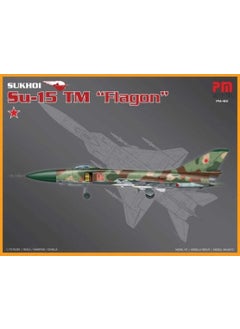Free & Easy Returns
Best Deals
| Material | Plastic |
PM Model 401 1/72 SU-15 TM Flagon Interceptor Aircraft Disassembled Plastic Model
SCALE: 1/72
Type: Disassembled Kit (Requires assembly and painting)
MATERIAL: PLASTIC
CONTENTS:
Plastic Injection Parts
1 Decal
1 Installation Manual
FEATURES:
It is made of disassembled plastic.
Glue and paint are not included in the box.
You can easily carry out the necessary assembly operations with the included assembly guide.
ABOUT:
Recognizing the limitations of the earlier Su-9 and Su-11 in intercepting the new Boeing B-52 Stratofortress, particularly in terms of radar and aircraft performance, Sukhoi OKB quickly began development of a revised and more capable aircraft. Several development aircraft evolved, including the Sukhoi T-49, which shared the Su-9's fuselage (including its single engine) but used cheek-mounted air intakes to leave the nose open for a large radome for the RP-22. Oryol-D ("Eagle") radar (NATO "Skip Spin") and the T-5, essentially a heavily modified Su-11 with an enlarged rear fuselage containing two Tumansky R-11 engines. These are the twin engines of the T-49' This led to the T-58, which incorporated a modified version of the navy nose, but with side air intakes further back behind the cockpit. It was approved for production as the Su-15 on 5 February 1962, and the prototype first flew on 30 May 1962. It entered service testing on 5 August 1963, but its entry into service was delayed due to political conflict with the Yakovlev OKB over the production line. Capacity in Novosibirsk, which also built the Yak-28P. The Su-15 proved to be superior in many respects beyond range and was officially commissioned on 3 April 1965. Series production began the following year and it entered service with the PVO in 1967, replacing the Su-11s with Su-9s and Yakovlev Yak-25s. The first Su-15 received the NATO reporting designation "Flagon-A". A simplified trainer version, the Su-15UT (NATO "Flagon-C"), entered service in 1970 with no radar or combat capability. The first delta-wing Su-15s had poor take-off and landing characteristics, and so the Sukhoi introduced extended wingtips ( investigated a new wing design with increased wing area) and boundary layer control. New-winged Su-15s entered production in 1969. They were designated "Flagon-D" by NATO, although the Soviet designation remained unchanged.

